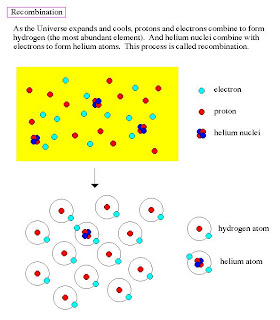In the past 20 years our understanding of physics and biology has noted a peculiar specialness
to our Universe, a specialness with regard to the existence of intelligent life. This sends up
warning signs from the Copernican Principle, the idea that no scientific theory should invoke a
special place or aspect to humans.
All the laws of Nature have particular constants associated with them, the gravitational
constant, the speed of light, the electric charge, the mass of the electron, Planck's constant
from quantum mechanics. Some are derived from physical laws (the speed of light, for
example, comes from Maxwell's equations). However, for most, their values are arbitrary. The
laws would still operate if the constants had different values, although the resulting
interactions would be radically different.
Examples:
gravitational constant: Determines strength of gravity. If lower than stars would have
insufficient pressure to overcome Coulomb barrier to start thermonuclear fusion (i.e. stars
would not shine). If higher, stars burn too fast, use up fuel before life has a chance to
evolve.
l
strong force coupling constant: Holds particles together in nucleus of atom. If weaker
than multi-proton particles would not hold together, hydrogen would be the only element
in the Universe. If stronger, all elements lighter than iron would be rare. Also radioactive
decay would be less, which heats core of Earth.
l
electromagnetic coupling constant: Determines strength of electromagnetic force that
couples electrons to nucleus. If less, than no electrons held in orbit. If stronger, electrons
will not bond with other atoms. Either way, no molecules.
l
All the above constants are critical to the formation of the basic building blocks of life. And,
the range of possible values for these constants is very narrow, only about 1 to 5% for the
combination of constants.

It is therefore possible to imagine whole different kinds of universes with different constants.
For example, a universe with a lower gravitational constant would have a weaker force of
gravity, where stars and planets might not form. Or a universe with a high strong force which
would inhibit thermonuclear fusion, which would make the luminosity of stars be much lower,
a darker universe, and life would have to evolve without sunlight.
The situation became worst with the cosmological discoveries of the 1980's. The two key
cosmological parameters are the cosmic expansion rate (Hubble's constant, which determines
the age of the Universe) and the cosmic density parameter ( ), which determines the
acceleration of the Universe and its geometry).
The flatness problem relates to the density parameter of the Universe, . Values for can
take on any number, but it has to be between 0.01 and 5. If is less than 0.01 the Universe is
expanding so fast that the Solar System flys apart. And has to be less than 5 or the Universe
is younger than the oldest rocks. The measured value is near 0.2. This is close to an of 1,
which is strange because of 1 is an unstable critical point for the geometry of the Universe.

Values slightly below or above 1 in the early Universe rapidly grow to much less than 1 or
much larger than 1 (like a ball at the top of a hill). So the fact that the measured value of 0.2 is
so close to 1 that we expect to find in the future that our measured value is too low and that the
Universe has a value of exactly equal to 1 for stability.
This dilemma of the extremely narrow range of values for physical constants is allowed for the
evolution of conscious creatures, such as ourselves, is called the anthropic principle, and has
the form:
Anthropic Principle: The Universe must have those properties which allow life to develop
within it at some stage in its history.
There are three possible alternatives from the anthropic principle;
There exists one possible Universe `designed' with the goal of generating and sustaining
`observers' (theological universe). Or...
1.
2. Observers are necessary to bring the Universe into being (participatory universe). Or...
An ensemble of other different universes is necessary for the existence of our Universe
(multiple universes)
Anthropic Principle and Circular Reasoning :
The usual criticism of any form of the anthropic principle is that it is guilty of a tautology or
circular reasoning.

With the respect to our existence and the Universe, the error in reasoning is that because we
are here, it must be possible that we can be here. In other words, we exist to ask the question
of the anthropic principle. If we didn't exist then the question could not be asked. So there is
nothing special to the anthropic principle, it simply states we exist to ask questions about the
Universe.
An example of this style of question is whether life is unique to the Earth. There are many
special qualities to the Earth (proper mass, distance from Sun for liquid water, position in
Galaxy for heavy elements from nearby supernova explosion). But, none of these
characteristics are unique to the Earth. There may exists hundreds to thousands of solar
systems with similar characteristics where life would be possible, if not inevitable. We simply
live on one of them, and we would not be capable of living on any other world.
This solution is mildly unsatisfying with respect to physical constants since it implies some
sort-of lottery system for the existence of life, and we have no evidence of previous Universes
for the randomness to take place.
















































